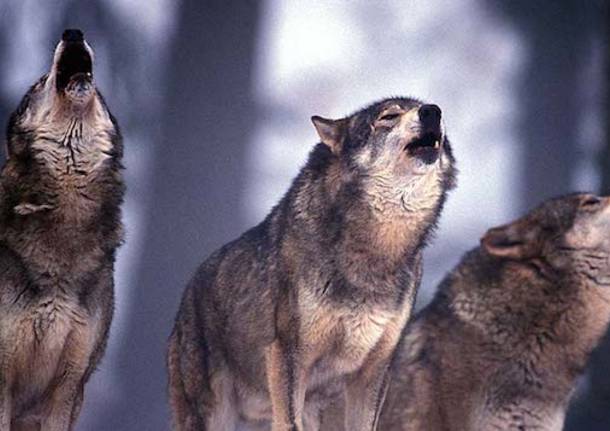The wolf has returned to the Pre-Alps, and made its home in Como
A pair arrived in 2015; now the pack has five members. And there is a European project to defend a species that controls the deer and wild boars populations.

One, two, three, four … The video camera focuses on the thick forest, where luminescent eyes, and tails that are not very long, have been seen on four occasions.
It is a little family that moves at night, between Italy and Switzerland, because that is their home: there are five wolves that live here, in the Lombard Pre-Alps, in Valle Albano, above Gravedona, in Como Province.
Wolves disappeared from the Alps a century ago, with only a few enduring until the 1970s, in the Central Apennines; now they have returned: first, they conquered Liguria and Piedmont, then the rest of the Alps, always moving east, and even breeding with foreign species, such as the Balkan wolf, which is what happened in the Lessini Mountains, above Verona.
EATING LIKE WOLVES – All data from an extremely well-attended seminar on the Varese site of Insubria University, in which students in Como also took part via videoconferencing, and at which many experts in this sector (including the fauna team of the Provincial Police) and many ecological guards were present. The reason why these “technicians” were present was explained in the second part of the work, when information on how to recognise the presence of this wonderful predator, which can rule over extremely vast areas and cover unimaginable distances, was given; so, not only their howls, but also an analysis of faeces and urine, or of what remains of their prey are important elements in understanding what we are dealing with.
Indeed, the prey: all sorts of stories have been told about wolves, but this animal, 95% of whose diet consists of meat, and which must consume between 3 and 6 kg a day (that is, 20 deer a year), kills “cleanly”, with just one bite to the neck (100 kg/cm2), tearing the trachea apart, ripping the carotid artery and reaching the animal’s vagus nerve, which regulates the heartbeat. The pray falls and the feast begins, lasting several “rounds”, until everything that can be eaten has been consumed.
This was explained very effectively by the zoologist Eugenio Carlini, from the Oikos Institute, which is involved in the LifeWolfAlps project, sponsored by the European Union to preserve this magnificent animal.
THE PACK – However, the pack in Como, like the one in Verona (which has grown to over 20 animals) must not misrepresent the stories about this animal, first of all, that it went from being wild to being domesticated, becoming a dog, and so, remained in the people’s minds as savage beasts, because of the examples that evolution kept far from man, ruling over the forests, the steppes and the mountains.
It is a shy, monogamous animal that lives in a social group; a pack starts with “an alpha male and an alpha female“, that colonise an area, breed and rule. And this is the point: the pack is not huge, it consists of the founders and of their successors, but when there is a shortage of food, many young animals are turned away and start to “scatter”.
They set off, and may be torn to pieces by other packs, or run over, like the male found dead in 2012 on the roads of Somma Lombardo. Or meet a female that is also alone, and colonise a new area.
LITTLE RED RIDING HOOD – “What’s the first word that comes to mind if I say wolf?” the teacher asked.
“Fear”, “Lamb”, “Carnivore”, the students said.
Some might say “Little Red Riding Hood.” Because this animal left a mark in popular beliefs and traditions. But there is some truth in them. Adriano Martinoli, a lecturer in Zoology and Conservation of Fauna at Insubria University, in Varese and Como, was the first, a few years ago, to gather attacks by wolves in Italy, at different times in history, in a book (which has now become a reference text on this topic). These are episodes that were reported first in parish registers, and then in newspapers, often with children as the victims. Why? “Because in past centuries, it was not uncommon to see children and young people employed as shepherds in the mountains. And in some conditions, if the wolf has to choose between attacking fast, powerful prey and slow, weak prey, it knows which to choose.”
It is an opportunist: it always chooses to kill the easiest animal.
But today, with the mountain uninhabited, it is a rare to photograph these animals, which have returned to the Alps, even from a distance; they are shy and fearful, especially when they smell a human presence.
La community di VareseNews
Loro ne fanno già parte
Ultimi commenti
Giulio Moroni su Barasso, il Comune rischia il blocco dei servizi per una sentenza di condanna da 300 mila euro
Stefano Montani su Contro l’indifferenza e la violenza: la musica scuote Varese in un grido per la Palestina
Felice su Sanpietrini staccati e resti di gavettoni: allarme maleducazione al Parco Mantegazza di Varese
Mastro SIM su Patentino obbligatorio per alcuni cani: la Lombardia vara la “save list”, ecco le razze coinvolte
Gloria Cerri su Patentino obbligatorio per alcuni cani: la Lombardia vara la “save list”, ecco le razze coinvolte
CarloP su Sanpietrini staccati e resti di gavettoni: allarme maleducazione al Parco Mantegazza di Varese
















Accedi o registrati per commentare questo articolo.
L'email è richiesta ma non verrà mostrata ai visitatori. Il contenuto di questo commento esprime il pensiero dell'autore e non rappresenta la linea editoriale di VareseNews.it, che rimane autonoma e indipendente. I messaggi inclusi nei commenti non sono testi giornalistici, ma post inviati dai singoli lettori che possono essere automaticamente pubblicati senza filtro preventivo. I commenti che includano uno o più link a siti esterni verranno rimossi in automatico dal sistema.